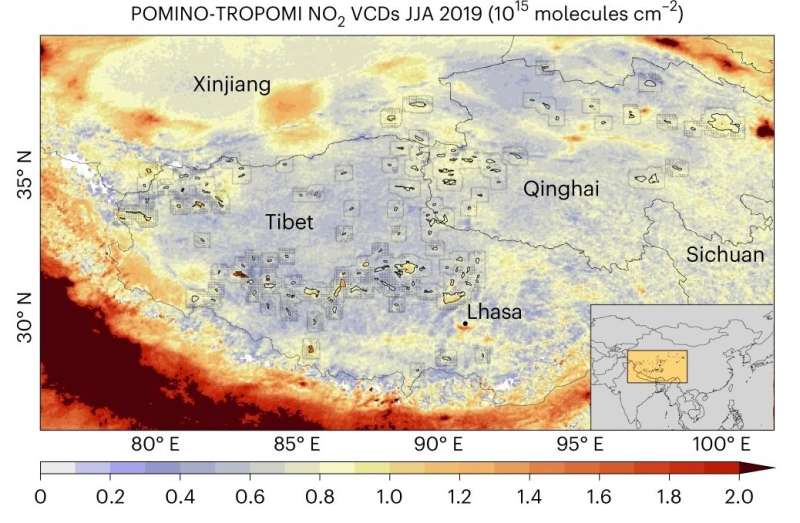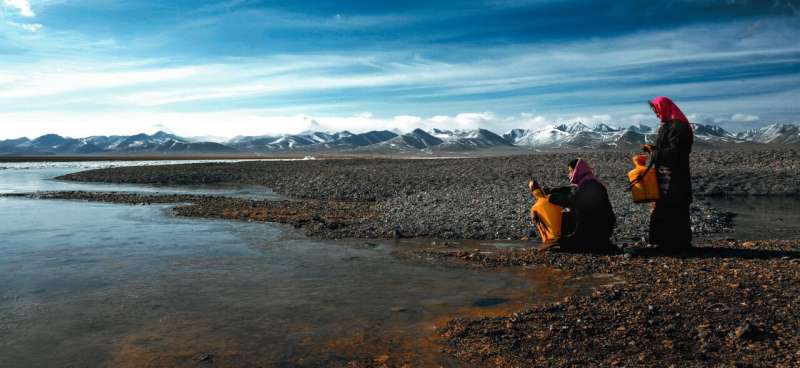June 26, 2023 feature
This article has been reviewed according to Science X's editorial process and policies. Editors have highlighted the following attributes while ensuring the content's credibility:
fact-checked
peer-reviewed publication
trusted source
proofread
Remote lake emissions from the Tibetan Plateau challenge global climate modeling

Earth's complex systems interact between atmospheric, terrestrial, hydrological, cryological (ice and snow) and biological processes in feedback loops. Understanding their relationships is important for modeling their future impacts, particularly regarding climate change.
Gases are known to impact climate, with nitrous oxides being considered the third most important greenhouse gas after carbon dioxide and methane. Nitric oxide can be derived from anthropogenic activities, such as power plants, vehicles, construction equipment and much more, but it is also found in lakes.
Generally, the nitric oxide in lakes has not been considered a major forcing factor in air quality or climate models compared to human sources, but new research reported in Nature Geoscience focused on remote lakes on the Tibetan Plateau (the intersection of central, south and east Asia) has challenged this understanding.
The Tibetan Plateau contains thousands of lakes and constitutes approximately half of the lake environments within China, and provides valuable water resources to over 2 billion people across China, India, Pakistan, Nepal, Bhutan, Tajikistan and Kyrgyzstan. These lakes tend to be in isolated regions with no outflows, creating alkaline (pH value of 9 to 12) and saline (concentrated with salts and other minerals) environments.
Researchers at the Laboratory for Climate and Ocean-Atmosphere Studies, Peking University, China, and their collaborators have used satellite observations of 135 lakes larger than 50 km2 (this size needed for efficient use of satellite data) to record total nitric oxide emissions of 1.9 metric tons per hour, comparable to the emissions from global megacities. For example, Beijing emits 7.8 tons of nitric oxide/hour, New York City 3 tons/hour, London 1.7 tons/hour and Paris 0.3 tons/hour. It also exceeded emissions from crop fields. For lakes in the south of the Tibetan Plateau, nitrogen dioxide levels were 31.2% higher than their immediate surroundings within a distance of 20 km.

The top ten lakes emitting nitric oxide coincide with regions experiencing the most urbanization and population growth, exacerbating warming across the Tibetan Plateau. Extraordinarily, Qinghai Lake had such high emissions (0.24 tons/hour) that they are comparable to those produced by a 450 megawatt capacity coal-fired power plant.
The cause of such unusually high levels of nitric oxide from the lakes has been attributed to a combination of microbial processes, alongside warming and melting of glaciers and permafrost on the plateau (though other sources also include lightning and combustion). Such processes convert the nitric oxide into nitrogen dioxide in the atmosphere, specifically the tropospheric level (up to an average 13 km above sea level), which is what is measured by the satellites.
Lake warming in summer is accelerating each decade at a rate of 0.40°C, with the melting of ice and permafrost resulting in the lakes growing in size and abundance on the plateau. The elevation of the lakes at 4.5 km to 5 km above sea level makes them prone to the severest impacts on glacier and permafrost degradation. Seasonal cyclicity in the nitrogen dioxide measurements found that summer peak values were twice those occurring in winter.
Within these lakes, particular bacteria thrive in the anoxic (low oxygen) environments, converting nitrogen from natural sources, agricultural runoff and sewage into ammonia, which is then converted into nitrites (nitrification) and subsequently nitrogen gas (denitrification), the latter of which creates nitric oxide as a by-product.
The formation of nitric oxide in such large quantities is problematic as it contributes to the depletion of the ozone layer, which forms a positive feedback mechanism for climate change. As the ozone layer becomes further damaged, more solar radiation can penetrate through down to Earth's surface, warming the planet. When the planet emits heat, the ever-growing greenhouse gas layer traps this heat, so rather than it escaping back out to space, it warms the planet further, creating a positive feedback loop.
While the nitrous oxide emissions from lakes have previously been considered unimportant when compared to anthropogenic sources, this report suggests that view needs to change. The researchers advocate for future modeling of global warming to include lake and inland water nitric oxide emissions worldwide to help us understand how all aspects of Earth's system may affect, and be affected by, climate change.
More information: Hao Kong et al, High natural nitric oxide emissions from lakes on Tibetan Plateau under rapid warming, Nature Geoscience (2023). DOI: 10.1038/s41561-023-01200-8
Journal information: Nature Geoscience
© 2023 Science X Network




















